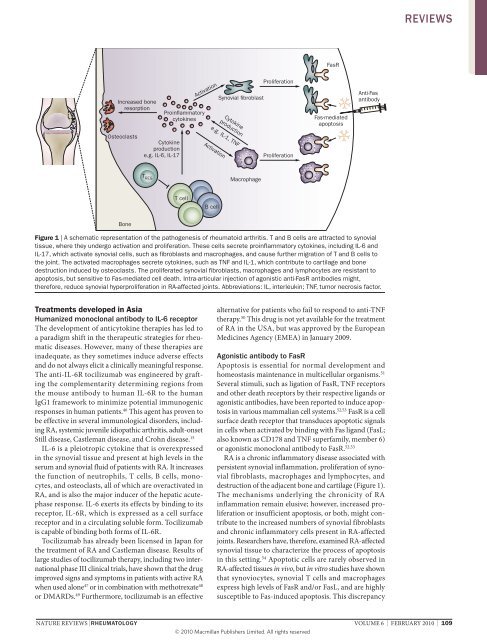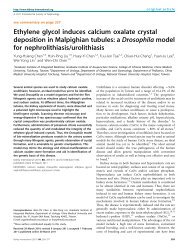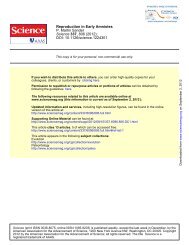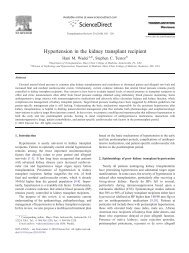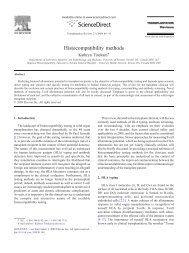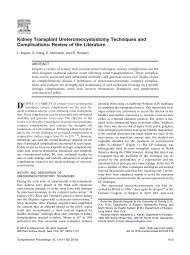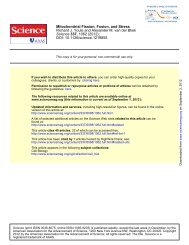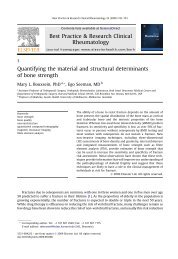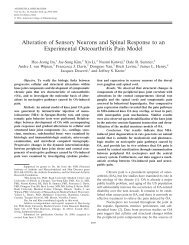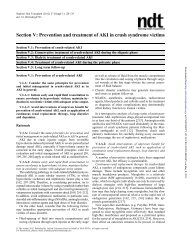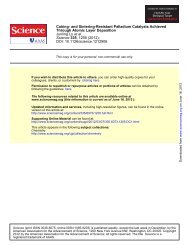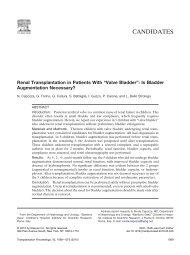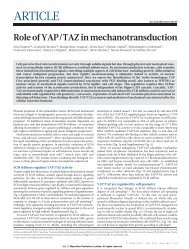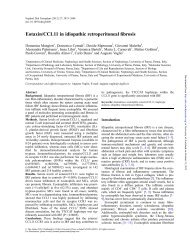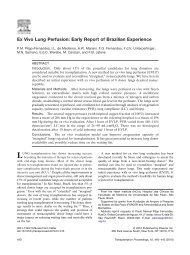The contribution of Asian researchers to the field of rheumatology
The contribution of Asian researchers to the field of rheumatology
The contribution of Asian researchers to the field of rheumatology
Create successful ePaper yourself
Turn your PDF publications into a flip-book with our unique Google optimized e-Paper software.
Increased bone<br />
resorption<br />
Osteoclasts<br />
Bone<br />
Cy<strong>to</strong>kine<br />
production<br />
e.g. IL-6, IL-17<br />
T REG<br />
Proinamma<strong>to</strong>ry<br />
cy<strong>to</strong>kines<br />
T cell<br />
Treatments developed in Asia<br />
humanized monoclonal antibody <strong>to</strong> il‑6 recep<strong>to</strong>r<br />
<strong>The</strong> development <strong>of</strong> anticy<strong>to</strong>kine <strong>the</strong>rapies has led <strong>to</strong><br />
a paradigm shift in <strong>the</strong> <strong>the</strong>rapeutic strategies for rheumatic<br />
diseases. However, many <strong>of</strong> <strong>the</strong>se <strong>the</strong>rapies are<br />
inadequate, as <strong>the</strong>y sometimes induce adverse effects<br />
and do not always elicit a clinically meaningful response.<br />
<strong>The</strong> anti-IL-6R <strong>to</strong>cilizumab was engineered by grafting<br />
<strong>the</strong> complementarity determining regions from<br />
<strong>the</strong> mouse antibody <strong>to</strong> human IL-6R <strong>to</strong> <strong>the</strong> human<br />
IgG1 framework <strong>to</strong> minimize potential immunogenic<br />
responses in human patients. 46 This agent has proven <strong>to</strong><br />
be effective in several immunological disorders, including<br />
RA, systemic juvenile idiopathic arthritis, adult-onset<br />
Still disease, Castleman disease, and Crohn disease. 15<br />
IL-6 is a pleiotropic cy<strong>to</strong>kine that is overexpressed<br />
in <strong>the</strong> synovial tissue and present at high levels in <strong>the</strong><br />
serum and synovial fluid <strong>of</strong> patients with RA. It increases<br />
<strong>the</strong> function <strong>of</strong> neutrophils, T cells, B cells, monocytes,<br />
and osteoclasts, all <strong>of</strong> which are overactivated in<br />
RA, and is also <strong>the</strong> major inducer <strong>of</strong> <strong>the</strong> hepatic acutephase<br />
response. IL-6 exerts its effects by binding <strong>to</strong> its<br />
recep<strong>to</strong>r, IL-6R, which is expressed as a cell surface<br />
recep<strong>to</strong>r and in a circulating soluble form. Tocilizumab<br />
is capable <strong>of</strong> binding both forms <strong>of</strong> IL-6R.<br />
Tocilizumab has already been licensed in Japan for<br />
<strong>the</strong> treatment <strong>of</strong> RA and Castleman disease. Results <strong>of</strong><br />
large studies <strong>of</strong> <strong>to</strong>cilizumab <strong>the</strong>rapy, including two international<br />
phase III clinical trials, have shown that <strong>the</strong> drug<br />
improved signs and symp<strong>to</strong>ms in patients with active RA<br />
when used alone 47 or in combination with methotrexate 48<br />
or DMARDs. 49 Fur<strong>the</strong>rmore, <strong>to</strong>cilizumab is an effective<br />
Activation<br />
Activation<br />
Synovial broblast<br />
Cy<strong>to</strong>kine<br />
production<br />
e.g. IL-1, TNF<br />
B cell<br />
Macrophage<br />
Proliferation<br />
Proliferation<br />
alternative for patients who fail <strong>to</strong> respond <strong>to</strong> anti-TNF<br />
<strong>the</strong>rapy. 50 This drug is not yet available for <strong>the</strong> treatment<br />
<strong>of</strong> RA in <strong>the</strong> uSA, but was approved by <strong>the</strong> European<br />
Medicines Agency (EMEA) in January 2009.<br />
Agonistic antibody <strong>to</strong> Fasr<br />
Apop<strong>to</strong>sis is essential for normal development and<br />
homeostasis maintenance in multicellular organisms. 51<br />
Several stimuli, such as ligation <strong>of</strong> FasR, TNF recep<strong>to</strong>rs<br />
and o<strong>the</strong>r death recep<strong>to</strong>rs by <strong>the</strong>ir respective ligands or<br />
agonistic antibodies, have been reported <strong>to</strong> induce apop<strong>to</strong>sis<br />
in various mammalian cell systems. 52,53 FasR is a cell<br />
surface death recep<strong>to</strong>r that transduces apop<strong>to</strong>tic signals<br />
in cells when activated by binding with Fas ligand (FasL;<br />
also known as CD178 and TNF superfamily, member 6)<br />
or agonistic monoclonal antibody <strong>to</strong> FasR. 52,53<br />
RA is a chronic inflamma<strong>to</strong>ry disease associated with<br />
persistent synovial inflammation, proliferation <strong>of</strong> synovial<br />
fibroblasts, macrophages and lymphocytes, and<br />
destruction <strong>of</strong> <strong>the</strong> adjacent bone and cartilage (Figure 1).<br />
<strong>The</strong> mechanisms underlying <strong>the</strong> chronicity <strong>of</strong> RA<br />
inflammation remain elusive; however, increased proliferation<br />
or insufficient apop<strong>to</strong>sis, or both, might contribute<br />
<strong>to</strong> <strong>the</strong> increased numbers <strong>of</strong> synovial fibroblasts<br />
and chronic inflamma<strong>to</strong>ry cells present in RA-affected<br />
joints. Researchers have, <strong>the</strong>refore, examined RA-affected<br />
synovial tissue <strong>to</strong> characterize <strong>the</strong> process <strong>of</strong> apop <strong>to</strong>sis<br />
in this setting. 54 Apop<strong>to</strong>tic cells are rarely observed in<br />
RA-affected tissues in vivo, but in vitro studies have shown<br />
that synoviocytes, synovial T cells and macro phages<br />
express high levels <strong>of</strong> FasR and/or FasL, and are highly<br />
susceptible <strong>to</strong> Fas-induced apop<strong>to</strong>sis. This discrepancy<br />
NATuRE REVIEWS | rheumATologY VOLuME 6 | FEBRuARY 2010 | 109<br />
FasR<br />
Fas-mediated<br />
apop<strong>to</strong>sis<br />
Anti-Fas<br />
antibody<br />
Figure 1 | A schematic representation <strong>of</strong> <strong>the</strong> pathogenesis <strong>of</strong> rheuma<strong>to</strong>id arthritis. T and B cells are attracted <strong>to</strong> synovial<br />
tissue, where <strong>the</strong>y undergo activation and proliferation. <strong>The</strong>se cells secrete proinflamma<strong>to</strong>ry cy<strong>to</strong>kines, including IL‑6 and<br />
IL‑17, which activate synovial cells, such as fibroblasts and macrophages, and cause fur<strong>the</strong>r migration <strong>of</strong> T and B cells <strong>to</strong><br />
<strong>the</strong> joint. <strong>The</strong> activated macrophages secrete cy<strong>to</strong>kines, such as TNF and IL‑1, which contribute <strong>to</strong> cartilage and bone<br />
destruction induced by osteoclasts. <strong>The</strong> proliferated synovial fibroblasts, macrophages and lymphocytes are resistant <strong>to</strong><br />
apop<strong>to</strong>sis, but sensitive <strong>to</strong> Fas‑mediated cell death. Intra‑articular injection <strong>of</strong> agonistic anti‑Fasr antibodies might,<br />
<strong>the</strong>refore, reduce synovial hyperproliferation in rA‑affected joints. Abbreviations: IL, interleukin; TNF, tumor necrosis fac<strong>to</strong>r.<br />
© 20 10<br />
Macmillan Publishers Limited. All rights reserved<br />
reviews


